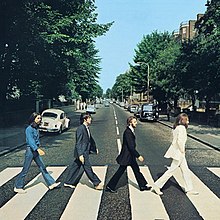
Back Abbey Road (album) Afrikaans آبي رود Arabic Abbey Road Azerbaijani Abbey Road Byelorussian Abbey Road BE-X-OLD Abbey Road (албум) Bulgarian Abbey Road (albom) Breton Abbey Road BS Abbey Road (disc) Catalan Abbey Road CEB
| Abbey Road | ||||
|---|---|---|---|---|
 | ||||
| Studio album by | ||||
| Released | 26 September 1969 | |||
| Recorded | 22 February – 20 August 1969 | |||
| Studio | EMI, Olympic and Trident, London | |||
| Genre | Rock[1] | |||
| Length | 47:03 | |||
| Label | Apple | |||
| Producer | George Martin | |||
| The Beatles chronology | ||||
| ||||
| The Beatles North American chronology | ||||
| ||||
| Singles from Abbey Road | ||||
| ||||
Abbey Road is the eleventh studio album by the English rock band the Beatles, released on 26 September 1969. It is the last album the group recorded,[2] although Let It Be was the last album completed before the band's break-up in April 1970.[3] It was mostly recorded in April, July, and August 1969, and topped the record charts in both the United States and the United Kingdom. A double A-side single from the album, "Something" / "Come Together", was released in October, which also topped the charts in the US.
Abbey Road incorporates styles such as rock, pop, blues, and progressive rock,[4] and makes prominent use of the Moog synthesiser and guitar played through a Leslie speaker unit. It is also notable for having a long medley of songs on side two that have subsequently been covered as one suite by other notable artists. The album was recorded in a more collegial atmosphere than the Get Back / Let It Be sessions earlier in the year, but there were still significant confrontations within the band, particularly over Paul McCartney's song "Maxwell's Silver Hammer", and John Lennon did not perform on several tracks. By the time the album was released, Lennon had left the group, though this was not publicly announced until McCartney also quit the following year.
Although Abbey Road was an instant commercial success, it received mixed reviews upon release. Some critics found its music inauthentic and criticised the production's artificial effects. By contrast, critics today view the album as one of the Beatles' best and one of the greatest albums of all time. George Harrison's two songs on the album, "Something" and "Here Comes the Sun", are considered among the best he wrote for the group. The album's cover, featuring the Beatles walking across the zebra crossing outside of Abbey Road Studios (then officially named EMI Studios), is one of the most famous and imitated of all time.
- ^ Matthews, Rex D. (2007). Timetables of History for Students of Methodism. Abingdon Press. p. 224. ISBN 978-1426764592.
- ^ MacDonald 1997, p. 300.
- ^ MacDonald 1997, p. 322.
- ^ Perone, James E. The Album: A Guide to Pop Music's Most Provocative, Influential, and Important Creations. p. 215.
© MMXXIII Rich X Search. We shall prevail. All rights reserved. Rich X Search